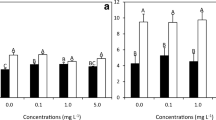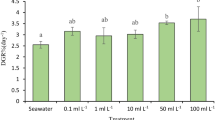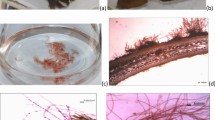Abstract
Gracilaria fisheri is an important red seaweed on the sea coast of Thailand. Cultivation of this seaweed has brought economic benefits to the farmers in this country. However, its low growth and quality are problematic due to high contamination and epiphyte outbreaks. This study was performed to examine the growth and epiphytic responses of G. fisheri to Ascophyllum seaweed extract (SE). The algal samples were treated with SE at different concentrations (0, 0.1, 0.5, and 1 g SE L–1). Three sets of experiments were conducted in the laboratory under controlled culture conditions of salinity of 30‰, temperature of 25–26°C, and light intensity of 200 μmol photons m–2 s–1. The algal samples were soaked for 30 min in SE alone (Experiment 1), in Provasoli Enriched Seawater (PES)+SE (Experiment 2), and in PES+SE with a 5% CO2 supplement (Experiment 3). The results showed a significant reduction in epiphytes (>90%) in the sample after one week of treatment with 1 g SE L-1. The use of SE significantly stimulated the branching of G. fisheri (p < 0.05). In comparison to the control plant (PES), the growth rate of the samples treated with PES+0.1 g SE L-1 was 3.40 ± 0.51% day-1 in the first week of culture, and this was increased to 3.84 ± 0.63% day-1 in the samples treated with PES+1 g SE L–1. The growth rate was significantly increased to 5.46 ± 1.05% day-1 in the samples treated with PES+1 g SE L-1 with a 5% CO2 supplement. This study suggested that the use of the Ascophyllum seaweed extract could inhibit epiphytic attachment and that supplementation with 5% CO2 resulted in enhanced growth of G. fisheri under controlled culture conditions.






Similar content being viewed by others
Data availability
All data generated or analysed during this study are included in this published article. Requests for material should be made to the corresponding authors.
References
Abdel-Mawgoud AMR, Tantaway A, Hafez MM, Habib HAM (2010) Seaweed extract improves growth, yield and quality of different watermelon hybrids. J Agric Biol Sci 6:161–168
Ali N, Farrell A, Ramsubhag A, Jayaraman J (2016) The effect of Ascophyllum nodosum extract on the growth, yield and fruit quality of tomato grown under tropical conditions. J Appl Phycol 28:1353–1362
Ali O, Ramsubhag A, Jayaraman J (2019) Biostimulatory activities of Ascophyllum nodosum extract in tomato and sweet pepper crops in a tropical environment. PLoS One 14:e0216710
Ali O, Ramsubhag A, Jayaraman J (2021) Biostimulant properties of seaweed extracts in plants: Implications towards sustainable crop production. Plants 10:531
Ask EI, Azanza RV (2002) Advances in cultivation technology of commercial eucheumatoid species: a review with suggestions for future research. Aquaculture 206:257–277
Bidwell RGS, McLachlan J, Lloyd NDH (1985) Tank cultivation of Irish Moss, Chondrus crispus. Bot Mar 28:87–97
Blunden G, Jenkins T, Liu YW (1996) Enhanced leaf chlorophyll levels in plants treated with seaweed extract. J Appl Phycol 8:535–543
Bold HC, Wynnw MJ (1978) Introduction to the algae: Structure and reproduction. Prentice-Hall, Engelwood Cliff
Borlongan IAG, Tibubos KR, Yunque DAT, Hurtado AQ, Critchley AT (2011) Impact of AMPEP on the growth and occurrence of epiphytic Neosiphonia infestation on two varieties of commercially cultivated Kappaphycus alvarezii grown at different depths in the Philippines. J Appl Phycol 23:615–621
Cai J, Lovatelli A, Aguilar-Manjarrez J, Cornish L, Dabbadie L, Desrochers A, Diffey S, Garrido Gamarro E, Geehan J, Hurtado A, Lucente D, Mair G, Miao W, Potin P, Przybyla C, Reantaso M, Roubach R, Tauati M, Yuan X (2021) Seaweeds and microalgae: an overview for unlocking their potential in global aquaculture development. FAO Fisheries and Aquaculture Circular No. 1229. FAO, Rome
Chirapart A (2008) A review of the Gracilaria (sensu latu) from Thailand. In: Phang SM, Lewmanomont K, Lim PE (eds) Taxonomy of Southeast Asian Seaweeds. Monograph Series 2. Institute of Ocean and Earth Sciences. University of Malaya, Kuala Lumpur, pp 45–61
Chirapart A, Praiboon J, Boonprab K, Puangsombat P (2018) Epiphytism differences in the commercial species of Gracilaria, G. fisheri, G. tenuistipitata, and G. salicornia, from Thailand. J Appl Phycol 30:3413–3423
Choi TS, Kang EJ, Kim J-H, Kim KY (2010) Effect of salinity on growth and nutrient uptake of Ulva pertusa (Chlorophyta) from an eelgrass bed. Algae 25:17–26
Danesh RK, Bidarigh S, Azarpour E, Moraditochaee M, Bozorgi HR (2012) Study effects of nitrogen fertiliser management and foliar spraying of marine plant Ascophyllum nodosum extract on yield of cucumber (Cucumis sativus L.). Int J Agric Crop Sci 4:1492–1495
Di Stasio E, Rouphael Y, Colla G, Raimondi G, Giordano M, Pannico A, El-Nakhel C, De Pascale S (2017) The influence of Ecklonia maxima seaweed extract on growth, photosynthetic activity and mineral composition of Brassica rapa L. subsp. sylvestris under nutrient stress conditions. Eur J Hortic Sci 82:286–293
Fan D, Hodges DM, Zhang JZ, Kirby CW, Ji XH, Locke SJ, Critchley AT, Prithiviraj B (2011) Commercial extract of the brown seaweed Ascophyllum nodosum enhances phenolic antioxidant content of spinach (Spinacia oleracea L.) which protects Caenorhabditis elegans against oxidative and thermal stress. Food Chem 124:195–202
Fritig B, Heitz T, Legrand M (1998) Antimicrobial proteins in induced plant defense. Curr Opin Immunol 10:16–22
Gao K (2021) Approaches and involved principles to control pH/pCO2 stability in algal cultures. J Appl Phycol 33:3497–3505
Gorman L, Kraemer GP, Yarish C, Boo SM, Kim JK (2017) The effects of temperature on the growth rate and nitrogen content of invasive Gracilaria vermiculophylla and native Gracilaria tikvahiae from Long Island Sound, USA. Algae 32:57–66
Hurtado AQ, Yunque DA, Tibubos K, Critchley AT (2009) Use of Acadian marine plant extract powder from Ascophyllum nodosum in tissue culture of Kappaphycus varieties. J Appl Phycol 21:633–639
Kang JW, Kambey C, Shen Z, Yang Y, Chung IK (2017) The short-term effects of elevated CO2 and ammonium concentrations on physiological responses in Gracilariopsis lemaneiformis (Rhodophyta). Fish Aquat Sci 20:1–8
Khan W, Rayirath UP, Subramanian S, Jithesh MN, Rayorath P, Hodges DM, Critchley AT, Craigie JS, Norrie J, Prithiviraj B (2009) Seaweed extracts as biostimulants of plant growth and development. J Plant Growth Regul 28:386–399
Kumar G, Sahoo D (2011) Effect of seaweed liquid extract on growth and yield of Triticum aestivum var. Pusa Gold. J Appl Phycol 23:251–255
Lakshmi D, Sheeja L (2021) Red seaweed extract as a biostimulant on growth and biochemical parameters of microalgae Chlorella vulgaris. IJMRASC 1:26–37
Lewmanomont K, Chirapart A (2022) Biodiversity, cultivation and utilization of seaweed in Thailand: an overview. In: Rao AR, Ravishankar GA (eds) Sustainable Global Resources of Seaweeds, Bioresources, Cultivation, Trade and Multifarious Applications, vol 1. Springer, Cham, pp 97–107
Liu L, Zou D, Jiang H, Chen B, Zeng X (2018) Effects of increased CO2 and temperature on the growth and photosynthesis in the marine macroalga Gracilaria lemaneiformis from the coastal waters of South China. J Appl Phycol 30:1271–1280
Lobban CS, Harrison PJ, Duncan MJ (1985) The Physiological Ecology of Seaweeds. Cambridge University Press, Cambridge
Loureiro RR, Reis RP, Critchley AT (2010) In vitro cultivation of three Kappaphycus alvarezii (Rhodophyta, Areschougiaceae) variants (green, red and brown) exposed to a commercial extract of the brown alga Ascophyllum nodosum (Fucaceae, Ochrophyta). J Appl Phycol 22:101–104
Mansori M, Chernane H, Latique S, Benaliat A, Hsissou D, El Kaoua M (2016) Effect of seaweed extract (Ulva rigida) on the water deficit tolerance of Salvia officinalis L. J Appl Phycol 28:1363–1370
Muangmai N, Zuccarello GC, Noiraksa T, Lewmanomont K (2014) A new flat Gracilaria: Gracilaria lantaensis sp. nov. (Gracilariales, Rhodophyta) from the Andaman coast of Thailand. Phycologia 53:137–145
Nor Salamah MH, Mohammad-Noor N, Susanti D, Saad S, Mukai Y (2015) The effects of different pH and salinities on growth rate and carrageenan yield of Gracilaria. J Teknol (Sci Eng) 77:1–5
Pooja K, Himabindu V (2012) CO2 removal from industrial flue gas using Botrycoccus branii for simultaneous lipid production. Int J Sci Res 3:366–373
Porse H, Rudolph B (2017) The seaweed hydrocolloid industry: 2016 updates, requirements, and outlook. J Appl Phycol 29:2187–2200
Rafiee H, Naghdi Badi H, Mehrafarin A, Qaderi A, Zarinpanjeh N, Sekara A, Zand E (2016) Application of plant biostimulants as new approach to improve the biological responses of medicinal plants- A critical review. J Med Plants 15:6–39
Rathore SS, Chaudhary DR, Boricha GN, Ghosh A, Bhatt BP, Zodape ST, Patolia JS (2009) Effect of seaweed extract on the growth, yield and nutrient uptake of soybean (Glycine max) under rainfed conditions. South Afr J Bot 75:351–355
Rayirath P, Jithesh MN, Farid A, Khan W, Palanisamy R, Hankins SD, Critchley AT, Prithiviraj B (2008) Rapid bioassays to evaluate the plant growth promoting activity of Ascophyllum nodosum (L.) Le Jol. using a model plant, Arabidopsis thaliana (L.) Heynh. J Appl Phycol 20:423–429
Reidenbach LB, Fernandez PA, Leal PP, Noisette F, McGraw CM, Revill AT, Hurd CL, Kübler JE (2017) Growth, ammonium metabolism, and photosynthetic properties of Ulva australis (Chlorophyta) under decreasing pH and ammonium enrichment. PLoS One 12:e0188389
Ruangsomboon S, Dimak J (2020) Optimum carbon dioxide concentrations for enhancing biomass and carbon dioxide biofixation of Scenedesmus dimorphus KMITL. King Mongkut’s Agr J 38:535–544 (in Thai)
Salles JP, Scherner F, Yoshimura CY, Fanganiello M, Bouzon ZL, Horta PA (2010) Cultivation of native seaweed Gracilaria domingensis (Rhodophyta) in Southern Brazil. Braz Arch Biol Technol 53:633–640
van Loon LC, van Strien EA (1999) The families of pathogenesis related proteins, their activities, and comparative analysis of PR-1 type proteins. Physiol Mol Plant Pathol 55:85–97
van Staden J, Becket RP, Rijkenberg MJ (1995) Effect of seaweed concentrate on the growth of the seedlings of three species of Eucalyptus. S Afr J Bot 61:169–172
Vernieri P, Borghesi E, Ferrante A, Magnani G (2005) Application of biostimulants in floating system for improving rocket quality. J Food Agric Environ 3:86–88
Xu Z, Zou D, Gao K (2010) Effects of elevated CO2 and phosphorus supply on growth, photosynthesis and nutrient uptake in the marine macroalga Gracilaria lemaneiformis (Rhodophyta). Bot Mar 53:123–129
Yoshimura T, Okada S, Honda M (2013) Culture of the hydrocarbon producing microalga Botryococcus braunii strain Showa: Optimal CO2, salinity, temperature, and irradiance conditions. Bioresour Technol 133:232–239
Zuldin WH, Shapawi R (2015) Performance of red seaweed (Kappaphycus sp.) cultivated using tank culture system. J Fish Aquat Sci 10:1–12
Acknowledgements
This research was facilitated by the Algal Bioresources Research Center, Department of Fishery Biology, Faculty of Fisheries, Kasetsart University. The authors would like to thank Dr. Alan T. Critchley for his kindly provide the seaweed extract AMPEP (Acadian marine plant extract powder) and for valuable comments. Thanks also to anonymous reviewers whose remarks helped to improve this paper.
Funding
This research was in kind supported (equipment, chemical reagents, etc.) by the Algal Bioresources Research Center, Department of Fishery Biology, Faculty of Fisheries, Kasetsart University.
Author information
Authors and Affiliations
Contributions
A. Chirapart designed all experiment, prepared figures 2 and 4, and wrote the main manuscript text. S. Khreauthong performed experiment and preparing figures 5, 6. J. Praiboon contributed the research work and discussion. S. Rattanasaensri performed experiment and preparing figures 1, 3. R. Ruangchuay provided all materials of Gracilaria fisheri and discussion.
Corresponding author
Ethics declarations
Competing interests
The authors have no competing interests to declare that are relevant to the content of this article.
Additional information
Publisher’s note
Springer Nature remains neutral with regard to jurisdictional claims in published maps and institutional affiliations.
Rights and permissions
Springer Nature or its licensor holds exclusive rights to this article under a publishing agreement with the author(s) or other rightsholder(s); author self-archiving of the accepted manuscript version of this article is solely governed by the terms of such publishing agreement and applicable law.
About this article
Cite this article
Chirapart, A., Khreauthong, S., Praiboon, J. et al. Growth and epiphytic responses of Gracilaria fisheri to Ascophyllum seaweed extract under controlled culture conditions. J Appl Phycol 34, 3107–3115 (2022). https://doi.org/10.1007/s10811-022-02827-7
Received:
Revised:
Accepted:
Published:
Issue Date:
DOI: https://doi.org/10.1007/s10811-022-02827-7




